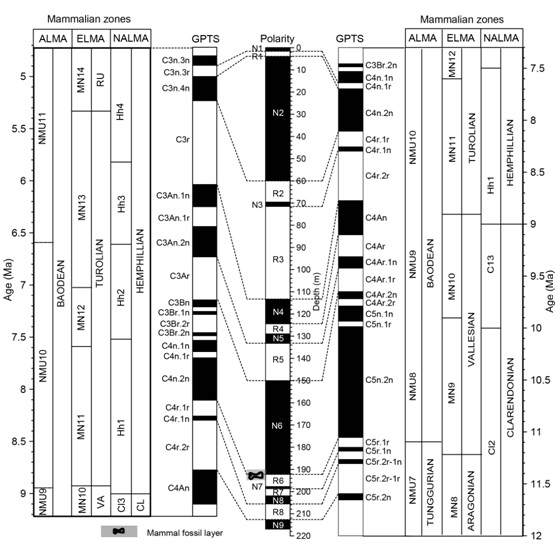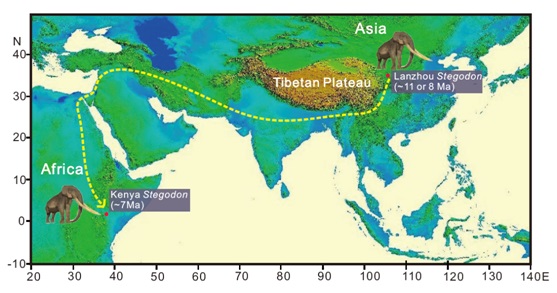Stegodon is an elephant-like proboscidean that was fairly common across Asia during the Plio-Pleistocene. It appeared during the late Miocene. The last representatives of the Stegodon disappeared in Indonesia (southeastern Asia) at the end of the Pleistocene, about 12,000 years ago. The traditional view is that Stegodon originated in Asia during the latest Miocene; a competing hypothesis is that this genus dispersed into Asia from Africa. The latter hypothesis is supported by a fossil Stegodon from Kenya, which is dated at 6.7–7.2 Ma with 40Ar/39Ar analyses of in situ tuffs. It currently represents the oldest known Stegodon record. If the traditional view is correct, then there should be Stegodon finds in Asia older than that in Kenya. Until now, however, the oldest evidence of Stegodon in Asia is from the upper Mahui Formation, Yushe Basin, northwest China. Another Stegodon fossil was found in the Xingjiawan Fauna from the Lanzhou Basin, which is located on the northeastern margin of the Tibetan Plateau. Except for a late Miocene age constrained by the biochronology, however, an precise numerical age remains unavailable for the Xingjiawan Fauna. Therefore, a precise numerical age constraints on the Xingjiawan Fauna is crucial to test whether Stegodon originated from Asia or Africa.
Professor AO Hong from Institute of Earth Environment, Chinese Academy of Sciences, and his collaborators provide numerical age constraints on the Xingjiawan Fauna (contained fossil Stegodon) with a detailed magnetochronological study of a well-exposed succession of fluvio-lacustrine sediments in the Lanzhou Base. The magnetochronological results suggest that the Late Miocene Xingjiawan Fauna is located either at the boundary between reversed polarity chron C4r.1r and normal polarity chron C4n.2n or at the boundary between subchrons C5r.1r and C5n.2n, with an estimated age of at least ~8 Ma or perhaps as early as ~11 Ma (Fig. 1). Both age estimations imply that the fossil Stegodon in the Lanzhou Basin is the oldest known record of Stegodon worldwide; it predates the former oldest Stegodon find from Africa by at least one million years and perhaps as many as four million years. This provides new evidence for an Asian origin (specifically from northwest China) for Stegodon. If it did originate from the northeastern margin of the Tibetan Plateau (e.g., Lanzhou Basin), it could have then dispersed to the Yushe Basin and to Africa in the latest Miocene (Fig. 2). This finding sheds new light on the origin of Stegodon.
Three of the six taxa in the Xingjiawan Fauna (i.e., Hyaena variabilis, Chilotherium haberei and Hipparion sp.) are taxonomically affiliated with typical grazing species that are indicative of an open grassland environment. The other three taxa (Stegodon sp., Chleuastochoerus stehlini and Cervidae indet.) are more adapted to woodland habitats. Therefore, this indicates a mixed woodland and grassland setting in Lanzhou Basin during the Late Miocene. Fossil elephants (e.g., Stegodon) and rhinoceroses (e.g., Chilotherium haberei) contrast with the sparse vegetation and absence of these animals and forests in the modern Lanzhou Basin. This contrast, together with widespread fluvio-lacustrine sediments, implies that Lanzhou Basin was probably warmer and more humid with much denser vegetation during the Late Miocene than today, in order to support large mammals such as rhinoceroses and elephants and other browsing mammals.
This study entitled “New magnetochronology of Late Miocene mammal fauna, NE Tibetan Plateau, China: mammal migration and paleoenvironments” has been published in Earth and Planetary Science Letters. This research was supported by grants from the National Natural Science Foundation of China and 973 program.
Futher Details: Dr. AO Hong, aohong@ieecas.cn. State Key Laboratory of Loess and Quaternary Geology, Institute of Earth Environment, Chinese Academy of Sciences, Xi'an 710075, China

Fig.1 Magnetostratigraphic dating of the Lanzhou Stegodon.(Image by AO Hong)

Fig.2 Stegodon dispersed to Africa from its origin in China during the late Miocene..(Image by AO Hong)
 © 2015 Institute of Earth Environment,CAS
© 2015 Institute of Earth Environment,CAS Address:No. 97 Yanxiang Road, Xi'an 710061, Shaanxi, China

 Location :
Location :